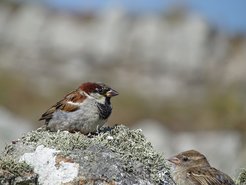Appearance is deceiving
Bib of house sparrow does not signal its fighting ability

The black throat patch of male house sparrows is a badge of status and signals their fighting abilities. This is at least how the “status signaling hypothesis” can be found in many behavioural and evolutionary ecology textbooks. It explains that plumage traits signal individual dominance.
Researchers of the Max Planck Institute for Ornithology in Seewiesen together with international colleagues now used a meta-analytic approach to quantitatively summarize all that is known about the status signalling hypothesis in house sparrows. They collected data from several populations across the world and systematically reviewed all the published literature on this topic. Despite the general belief, they found only weakening evidence that the bib of male house sparrows signals the fighting abilities of its bearer. “Our meta-analysis shows the need for abundant replication before we can robustly conclude about a hypothesis,” says Alfredo Sánchez-Tójar, first author of the study. Most previous studies on this topic were based on limited sample sizes, and used inconsistent methodologies. They summarize that the published literature is a biased and misleading subsample due to publication bias.
Another study from Seewiesen published earlier this year already contradicted established knowledge on the role of ornaments for mate choice in monogamous species. Here, too, the researchers found that positive results were only reported when sample sizes were small.
"Our study with the sparrows highlights some of the problems with the current scientific culture, where failures to replicate previous findings are generally deemed as uninteresting, and thus, not often published, leading to biased conclusions across fields, " says Julia Schroeder, former research group leader in Seewiesen. “Publication bias can be extremely misleading, and thus more efforts are needed to prevent this type of bias."












